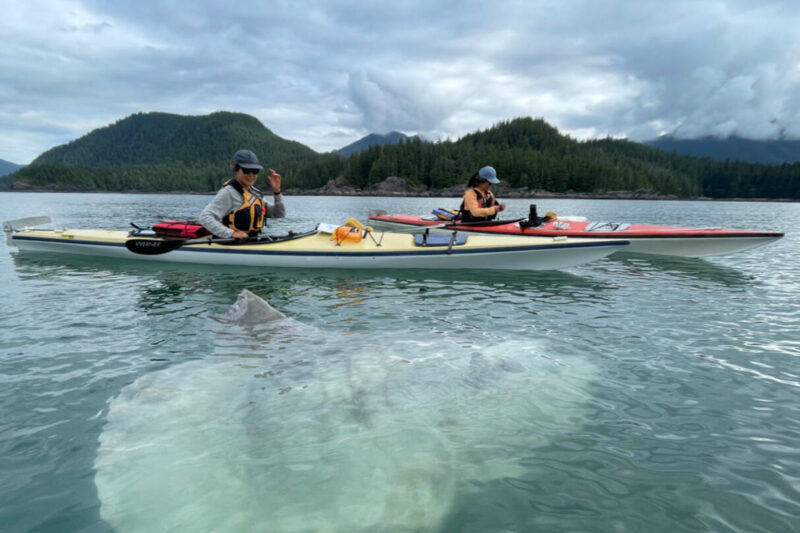By Rochelle Baker, Local Journalism Initiative Reporter CANADA’S NATIONAL OBSERVER
Sunfish sightings continue to surface on the West Coast and — Holy Mola! — some examples are pretty big ones.
Jackie Hildering is a researcher with the Marine Education Resource Society, based on northern Vancouver Island. She was astonished by a recent photo depicting an enormous Mola mola submitted to the citizen science project, which is collecting data on two different species of sunfish along the Pacific Coast.
The photo taken in Kyuquot Sound in early August off western Vancouver Island clearly shows the creature’s impressive size, said Hildering, noting Molas can be huge, reaching upwards of three metres.
An experienced diver and MERS’ education director, Hildering has seen Molas in the past during ocean surveys, but the photo highlights just how magnificent the mysterious fish can be, she said.
“It’s such a striking photo. You can see how big it is next to the kayaks,” she said.
The type of Mola in the photo, also known as an ocean sunfish, is one of two species MERS is hoping the public will help collect information on in waters from California to Alaska.
The other Mola species found in West Coast waters is the Mola tecta, also aptly named the hoodwinker sunfish because until recently, it was misidentified as ocean sunfish and so went undetected in waters in the Pacific Northwest, Hildering said.
“They’ve been hiding in plain sight all this time.”.
The existence of the hoodwinker species was confirmed by New Zealand marine scientist Marianne Nyegaard in 2017, Hildering said.
But it was thought the hoodwinker only frequented the warmer waters of the Southern Hemisphere until Nyegaard discovered social media posts in 2019 with Mola photos from northwest waters misidentifying the specimens as ocean sunfish rather than the newer identified species.
Since then, Nyegaard and other researchers have found other social media posts that show both ocean and hoodwinker sunfish along the West Coast, Hildering said.
MERS is helping collect data on sightings from the public to get a better understanding of the distribution of both types of the Mola fish, she said.
Sightings of Molas are infrequent but not rare and usually take place when the fish is lounging on the surface, an activity that attracts seabirds which will peck off parasites from the marine giants, Hildering said.
The record for the heaviest sunfish weighed to date is 2.3 tonnes, but the giant bony fish are surprisingly agile and fast and can leap from the water when chased by predators, she added.
MERS has collected 23 citizen reports on both kinds of Molas this year, she said.
The recent photo and others submitted by the public demonstrate the value of crowd-sourced science in solving marine mysteries and how much is left to be learned about marine ecosystems, Hildering said.
“The beauty of citizen science is people can help provide pieces to these ocean puzzles.”
To report a Mola sighting to MERS (with photo and/or video) and read about the differences between the two species, visit the MERS website.
* * * * *
Plan your adventures throughout the West Coast at westcoasttraveller.com and follow us on Facebook and Instagram @thewestcoasttraveller. And for the top West Coast Travel stories of the week delivered right to your inbox, sign up for our weekly Armchair Traveller newsletter!











 Why mountain biking should be your new travel activity — plus tips for beginners
Why mountain biking should be your new travel activity — plus tips for beginners